Snowline Gold Intersects 466.6 m of 1.1 Grams per Tonne Gold from Surface Including 154.0 m of 2.1 Grams per Tonne Gold Further Building on Continuity and Width at Its Valley Deposit, Yukon
- Hole V-24-105 returned 1.12 g/t Au over 466.6 m from surface, including 2.07 g/t Au over 154.0 m, strong results infilling a 120 m gap along section
- Hole V-24-111 returned 1.05 g/t Au over 403.6 m from surface, including 1.90 g/t Au over 103.0 m from a 108 m gap along section near the eastern extent of drilling
- Results from Aurelius show widespread alteration and anomalous gold (with local visible gold) in volcanic country rocks, along with broad zones of elevated copper
- Assays remain pending for >7,200 m from 17 holes across two targets at Snowline's Rogue and Einarson projects.
accessnewswire.com
Thursday, 30 January 2025 06:00 AM
VANCOUVER, BC / ACCESS Newswire / January 30, 2025 / SNOWLINE GOLD CORP (TSX-V:SGD)(OTCQB:SNWGF) (the "Company" or "Snowline") is pleased to announce further results from its 2024 drill campaign on the Valley deposit along with analytical results at its nearby Aurelius target on the Rogue Project, Yukon. At Valley, holes V-24-105 and V-24-111 delivered strong, consistent mineralization from infill holes in gaps along the margins of the high-grade, near-surface core of the deposit. Additional expansionary holes delivered broad intervals above the cut-off grade used in the initial Mineral Resource Estimate (MRE) for Valley, including mineralization outside of the resource-limiting pit shell (e.g. V-24-108, Figure 3). These results will help to inform an updated MRE for Valley anticipated in the coming months. Results are pending for an additional >7,200 m of drilling in 17 holes across two different targets: Valley (Rogue Project) and Jupiter (Einarson Project).

Table 1 - Highlight summary of Snowline's latest assay results; see Table 2 for details. *Interval widths reported.
"It is encouraging to see how well the Valley gold deposit holds up to the scrutiny of additional drilling, with highlight holes consistently appearing as we fill in the blanks," said Scott Berdahl, CEO & Director of Snowline. "Each round of results has brought large intervals with strong gold grades. We are gaining confidence and pushing the boundaries of our understanding of this unique and continuous near-surface gold deposit.
"At our nearby Aurelius target, we are intrigued by the widespread gold anomalism encountered on surface and in Phase I drilling. The hunt will continue, at Aurelius and at other targets, building on our expanding data and knowledge bases as we seek to establish a new gold district in the fertile and proven Selwyn Basin rocks around Valley."

Figure 1 - Plan map of drill results and progress on the Rogue Project's Valley deposit, highlighting current results in drill holes V-24-105 through V-24-111. Past analytical results are faded, while instances of visible gold in holes awaiting assay are marked by yellow spheres. Drill holes with assays pending (13 holes from Valley) are denoted by blue collars.
VALLEY DRILLING, ROGUE PROJECT
Hole V-24-105
Hole V-24-105 is collared within the Valley intrusion as a 66 m step back along section from V-23-066 (383.0 m @ 2.00 g/t Au including 107.5 m @ 3.95 g/t Au from surface, see January 15, 2024 news release) and 33 m southeast along strike from nearest hole V-23-034 (418.3 m @ 1.88 g/t Au from surface including 216.0 m @ 3.08 g/t Au, see July 5, 2023 news release). The hole is drilled to the southwest, testing continuity of strong gold mineralization predicted by the Valley deposit block model in the northeastern part of the Valley deposit.
The hole runs primarily through coarse-grained granodiorite for the top 340 m, at which point it contacts a fine-grained porphyritic intrusive breccia underlying Valley's near-surface high-grade zone. The fine-grained porphyritic phase of the intrusion continues to the end of hole at 509 m. Quartz vein densities are highest between 242-328 m downhole, in the zone above the porphyritic phase.
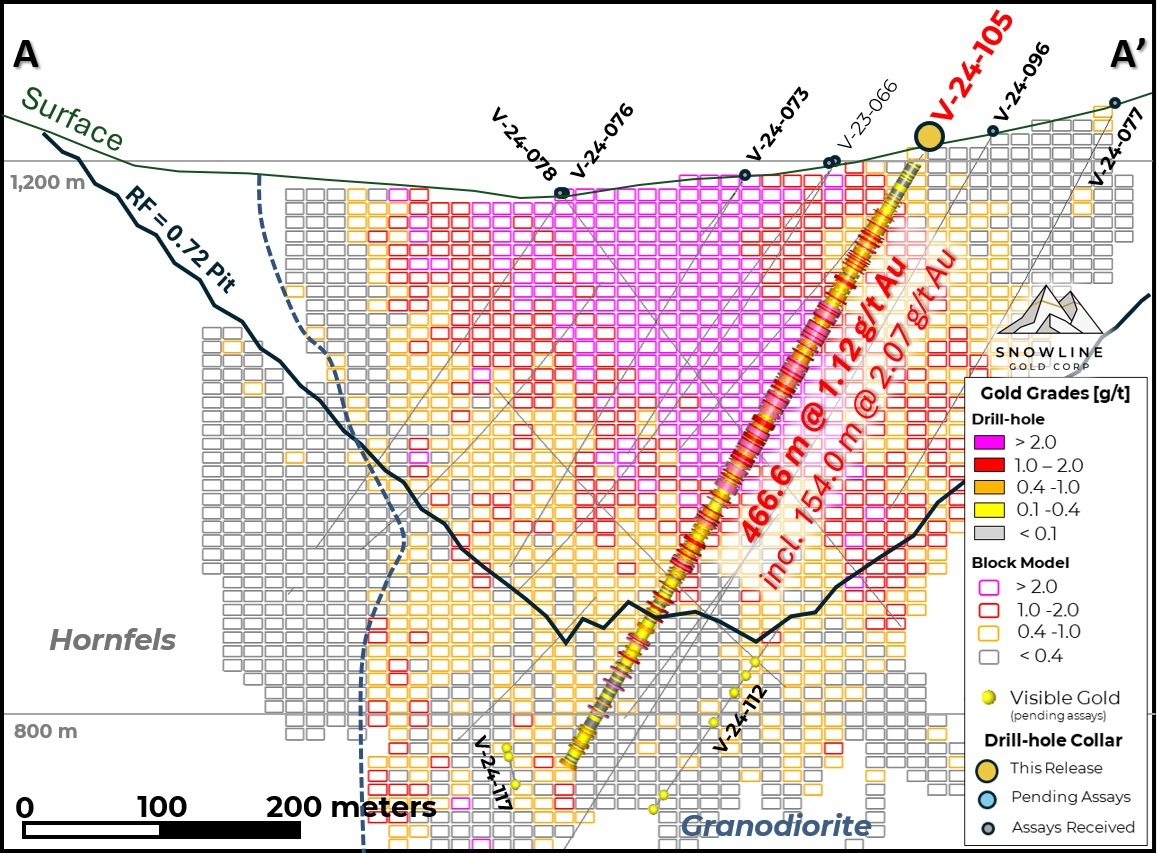
Figure 2 - Cross-section A-A', showing V-24-105 in the context of the initial Valley MRE block model and MRE-constraining revenue factor 0.72 pit shell. The block model has not been updated to reflect the current results, nor any results to date from 2024 (bold labels). Blocks shown outside of the current pit shell constraint are not included in the initial MRE for Valley. Areas without blocks have not been modelled and were assumed as nil for the initial Valley MRE. Instances of visible gold in holes still awaiting assay results are marked by yellow spheres.
The hole returned 1.12 g/t Au over 466.6 m downhole from bedrock surface at 3.4 m downhole, including 154.0 m downhole at 2.09 g/t Au starting from 124.0 m depth. As with many holes drilled at Valley, interval grades are not substantially affected when assays are capped at 10 g/t Au-in this case dropping by less than 1% (Table 2)-showcasing the consistent nature of gold mineralization along the breadth of the interval.
These results and those of other holes reported herein are expected to help upgrade, de-risk and potentially expand relevant areas of the initial MRE for Valley. The ultimate effect of this result will be quantified along with analytical results of all subsequent holes in an updated MRE at a later time.
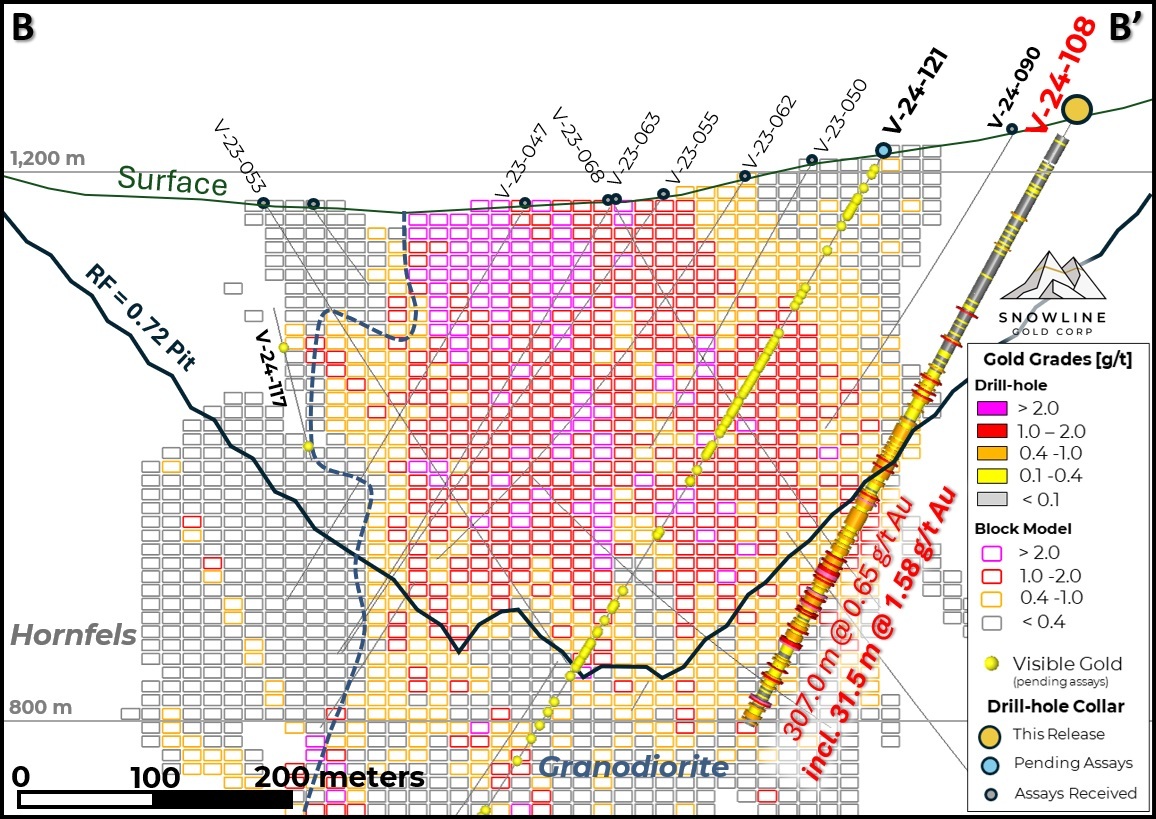
Figure 3 - Cross-section B-B', showing V-24-108 in the context of the initial Valley MRE block model and MRE-constraining revenue factor 0.72 pit shell. Note that most of the mineralization in the hole is outside the current resource-limiting pit shell. The block model has not been updated to reflect the current results, nor any results to date from 2024 (bold labels). Blocks shown outside of the current pit shell constraint are not included in the initial MRE for Valley. Areas without blocks have not been modelled and were assumed as nil for the initial Valley MRE. Instances of visible gold in holes still awaiting assay results are marked by yellow spheres.

Figure 4 - Relatively coarse native gold as seen in various Valley drill holes reported herein. Gold mineralization at Valley primarily consists of native gold hosted in quartz veins crosscutting the mid Cretaceous Valley intrusion and surrounding sedimentary rocks. Visible gold is common, with tens to hundreds of occurrences per hole consistently observed in well mineralized holes throughout the deposit, and one vein bearing visible gold observed on average once every 7.2 m throughout all 53 km drilling at Valley to date. Gold often occurs proximal to various minor bismuth and tellurium sulphide minerals and alloys (metallic grey minerals in above figures). As previously disclosed, the nature of this gold mineralization renders it available for high recovery rates from various conventional processing techniques, even in non-oxidized rock, as seen in initial metallurgical tests (94% average bottle roll cyanidation to 96% carbon-in-leach). All images are displayed at the same scale.
AURELIUS DRILLING, ROGUE PROJECT
Analytical results from Aurelius confirm the presence of gold mineralization hosted in volcanic units affected by alteration thought to be caused by a reduced intrusion-related gold system. The strongest intervals of gold mineralization (Table 2) are commonly associated with anomalous bismuth and tellurium, with low levels of arsenic-a geochemical fingerprint similar to that of Valley and similar to surface samples taken from the Aurelius target in 2023. One instance of trace visible gold was located at 344.0 m downhole depth in AU-24-003, with a Valley-style association to anomalous bismuth.
Elevated copper grades of up to 0.07% over 120.5 m, including 0.10% Cu over 38.5 m (AU-24-002, true widths unknown) are present in broad silicified zones of felsic and mafic tuffs and siltstone, associated with elevated concentrations of certain rare earth elements (Nd, La, Ce & Pr) relative to background. Certain anomalous gold values appear to be spatially associated with the upper levels of these copper zones.
This first-ever drill program at Aurelius tested a relatively small physical footprint within the broader zone of alteration and anomalous geochemistry and mineralization observed on surface. The suspected intrusive source of this widespread alteration and mineralization was not intersected by this initial phase, and a majority of the target area remains untested. Metre-scale, felsic, biotite-quartz+/-feldspar porphyritic sills of uncertain age were encountered in holes AU-24-001, AU-24-003 and AU-24-004. Age date samples of material from these sills have been submitted for analysis, with results pending.
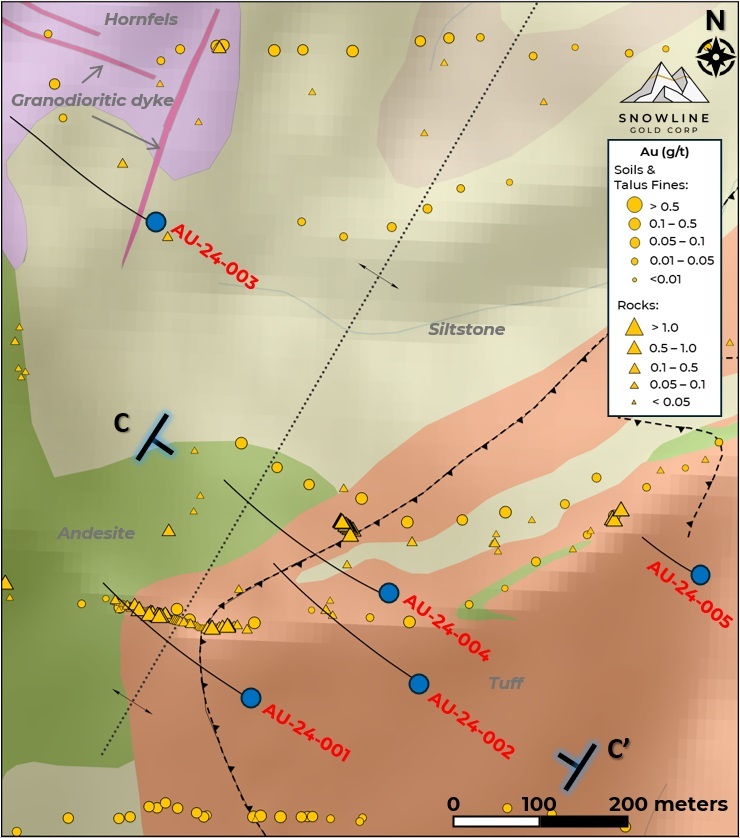
Figure 5 - Plan view of Aurelius drill holes from 2024 atop geological mapping and surface geochemical results. The 2024 drill program at Aurelius was the first ever drill test of the target, which covers a broader 2 km by 500 m footprint (Figure 6). A schematic cross section including AU-24-002 and AU-24-004 is shown in Figure 7.

Figure 6 - Broad-scale view of the Aurelius target, showing the context of Figure 5 drill locations amidst a wider geochemical anomaly accompanied by widespread hydrothermal alteration associated with proximal (and possibly buried) mid-Cretaceous granodioritic intrusions.

Figure 7 - Cross-section C-C', showing gold and copper results alongside a schematic representation of local geology. Anomalous gold mineralization was encountered in both holes, accompanied by zones of elevated copper mineralization associated with silicification and local hydrothermal brecciation.
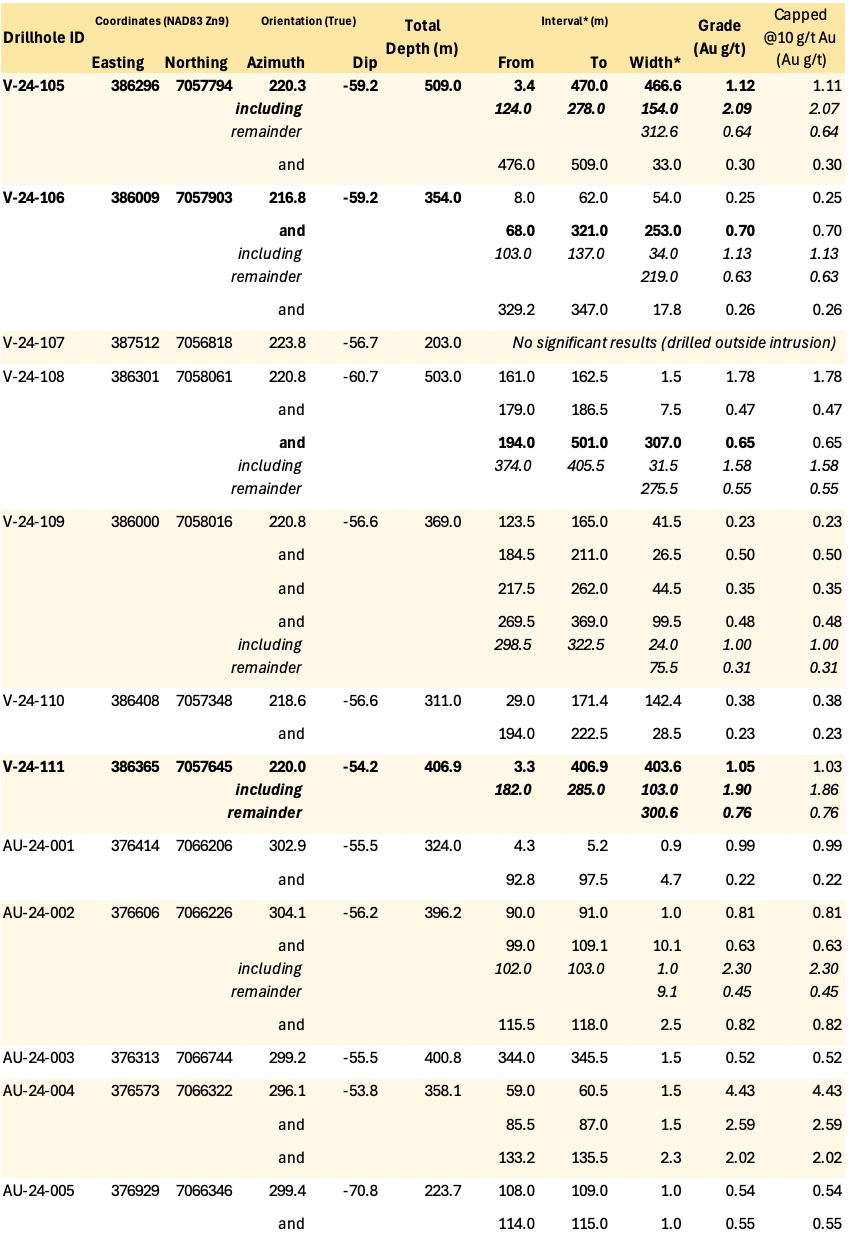
Table 2 - Summary of significant mineralization returned from current holes from Valley and other targets. The consistency of strong mineralization in the Valley deposit is reinforced by the capped values in the rightmost column, wherein any assay result >10 g/t Au is replaced by 10.0 g/t Au to calculate the average interval grades. Holes with prefixes "AU" are from the Aurelius target, roughly 12 km northwest of the Valley deposit on the Rogue Project (Figure 8). Rounding errors may be present in interval lengths. *Interval widths reported; true widths of the Valley system are complex, with different vein generations, orientations, and grade distributions present within various intervals through the bulk tonnage gold target at Valley.
QA/QC
On receipt from the drill site NQ2-sized drill core was systematically logged for geological attributes, photographed and sampled at Snowline's "Forks" Camp. Sample lengths as small as 0.5 m were used to isolate features of interest, but most samples within moderate to strong mineralization were 1.0 m in length; otherwise, a default 1.5 m downhole sample length was used. Core was cut in half lengthwise along a pre-determined line, with one half (same half, consistently, dictated by orientation line where present or by dominant vein orientation where absent) collected for analysis and one half stored as a record. Field duplicates were collected at regular intervals as ¼ core samples by splitting the ½ core sent for sampling, leaving a consistent record of half core material from duplicate and non-duplicate samples alike. Standard reference materials and blanks were inserted by Snowline personnel at regular intervals into the sample stream. Bagged samples were sealed with security tags to ensure integrity during transport. They were delivered by expeditor to Bureau Veritas' preparatory facility in Whitehorse, Yukon. Sample preparation was completed in Whitehorse, with analyses completed in Vancouver.
Bureau Veritas is accredited to ISO/IEC 17025 and ISO9001 for quality management. Samples were crushed by BV to >85% passing below 2 mm and split using a riffle splitter. 250 g splits were pulverized to >85% passing below 75 microns. A four-acid digest with an inductively coupled plasma mass spectroscopy (ICP-MS) finish was used for 59-element analysis on 0.25 g sample pulps (BV code: MA250). All samples were analysed for gold content by fire assay with an atomic absorption spectroscopy (AAS) finish on 30 g samples (BV code: FA430). Any sample returning >10 g/t Au was reanalysed by fire assay with a gravimetric finish on a 30 g sample (BV code: FA530).
For the purposes of this release, contiguous mineralized intervals at Valley are defined as runs of mineralization with no break >5.0 m assaying <0.1 g/t Au and may include any highlight subsections thereof.
ABOUT ROGUE
Snowline Gold's 100%-owned, flagship Rogue Project, in Canada's Yukon Territory, covers a 60 x 30 km cluster of intrusions in the eastern Tombstone Gold Belt known as the Rogue Plutonic Complex.
Since its launch in 2021, Snowline has progressed the Rogue Project's Valley deposit from a greenfield prospecting discovery to a significant bulk tonnage gold resource, with 4.05 Moz gold indicated mineral resource at 1.66 g/t Au and an additional 3.26 Moz inferred mineral resource at 1.25 g/t Au within a pit-shell constraint. The resource estimate numbers are supported by the recent technical report for Rogue, prepared in accordance with NI 43-101 standards, entitled "Rogue Gold Project: NI 43-101 Technical Report and Mineral Resource Estimate," authored by Heather Burrell, P. Geo., Daniel J. Redmond, P. Geo., and Steven C. Haggarty, P. Eng., with an effective date of May 15, 2024.
Exploration of the open Valley deposit is ongoing. Valley is a reduced intrusion-related gold system (RIRGS), geologically similar to multi-million-ounce RIRGS deposits currently in production, like Kinross's Fort Knox Mine in Alaska, but with substantially higher gold grades. Gold is associated with bismuthinite and telluride minerals hosted in sheeted quartz vein arrays within and along the margins of a one-kilometer-scale, mid-Cretaceous aged Mayo-series intrusion.
The Rogue Project area hosts multiple intrusions similar to Valley along with widespread gold anomalism in stream sediment, soil and rock samples. Elsewhere, RIRGS deposits are known to occur in clusters. For these reasons, Snowline considers the Rogue Project to have district-scale potential to host additional reduced intrusion-related gold systems.
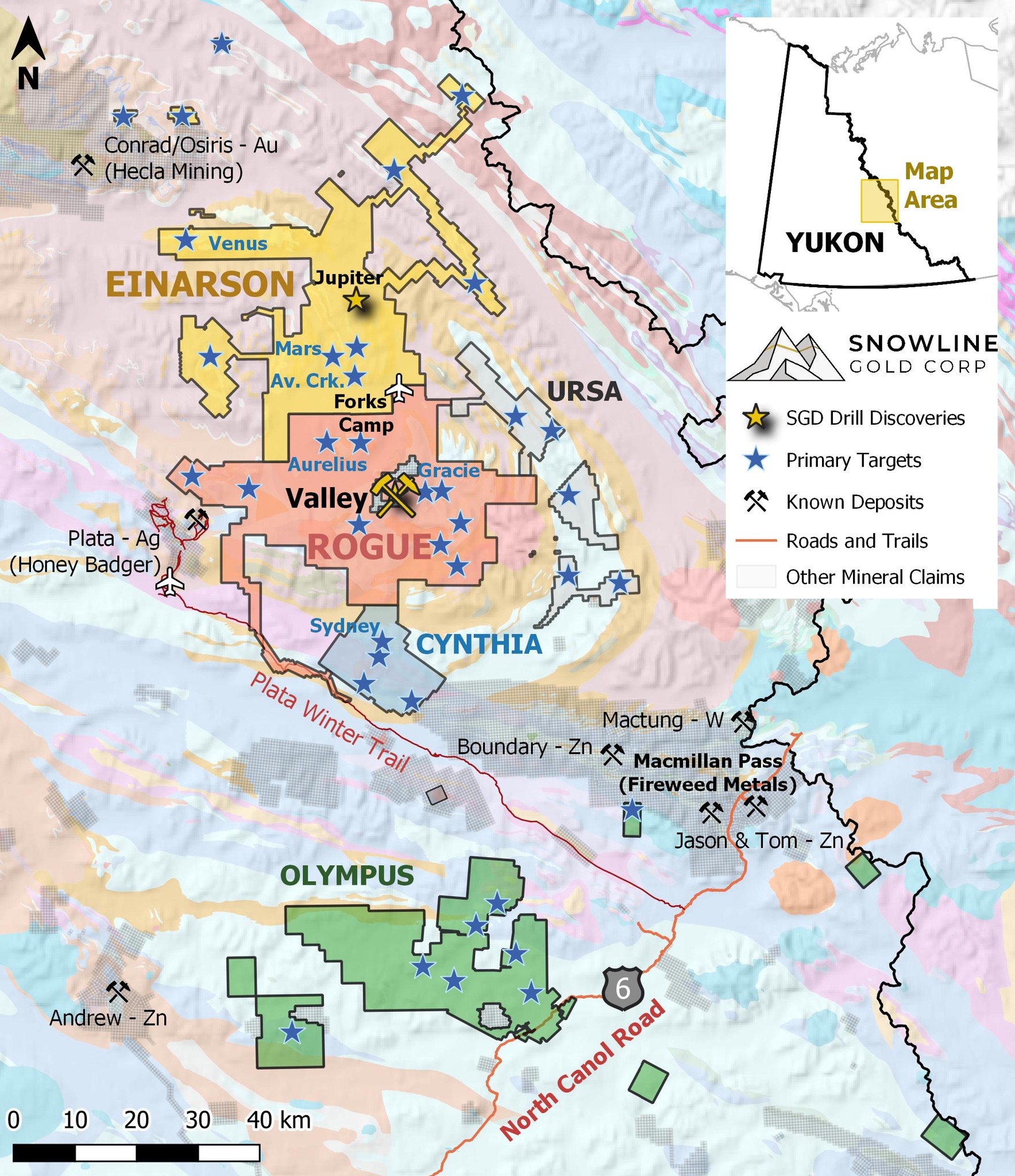
Figure 8 - Project location map for Snowline Gold's eastern Selwyn Basin properties: Rogue, Einarson, Ursa, Cynthia and Olympus. The Valley deposit and the Aurelius target are two of several prospective reduced intrusion-related gold targets on the broader 30 x 60 km Rogue Project.
ABOUT SNOWLINE GOLD CORP.
Snowline Gold Corp. is a Yukon Territory focused gold exploration and development company with an eight-project portfolio covering roughly 360,000 ha (3,600 km2). The Company is advancing its Valley deposit-a large, low-waste, near surface, >1 g/t Au bulk tonnage gold system located in the eastern Yukon-while continuing regional exploration of surrounding targets on the Rogue Project and the broader district in the highly prospective yet underexplored Selwyn Basin.
Snowline's project portfolio sits within the prolific Tintina Gold Province, host to multiple million-ounce-plus gold mines and deposits across the central Yukon and Alaska. The Company's comprehensive first-mover position and extensive exploration database provide a distinct competitive advantage and a unique opportunity for investors to be part of multiple discoveries, the advancement of a significant gold deposit, and the creation of a new gold district.
QUALIFIED PERSON
Information in this release has been prepared under supervision of and approved by Thomas Branson, M.Sc., P. Geo., Vice President of Exploration for Snowline Gold Corp, as Qualified Person for the purposes of National Instrument 43-101.
ON BEHALF OF THE BOARD
Scott Berdahl
CEO & Director
For further information, please contact:
Snowline Gold Corp.
+1 778 650 5485
info@snowlinegold.com
Neither TSX Venture Exchange nor its Regulation Services Provider (as that term is defined in policies of the TSX Venture Exchange) accepts responsibility for the adequacy or accuracy of this release.
CAUTIONARY NOTE REGARDING FORWARD-LOOKING STATEMENTS
This news release contains certain forward-looking statements, including statements regarding the significance of analytical results, the significance of visual drill core observations and visible gold, the potential effects of current analytical results on future mineral resource estimates including expansion of the pit shell and de-risking of the current estimate, the discovery potential within the Valley intrusion and on other exploration targets, the potential for investors to participate in multiple future discoveries, the Rogue Project having district-scale prospectivity, the creation of a new gold district and the Company's future plans and intentions. Wherever possible, words such as "may", "will", "should", "could", "expect", "plan", "intend", "anticipate", "believe", "estimate", "predict" or "potential" or the negative or other variations of these words, or similar words or phrases, have been used to identify these forward-looking statements. These statements reflect management's current beliefs and are based on information currently available to management as at the date hereof.
Forward-looking statements involve significant risk, uncertainties and assumptions. Many factors could cause actual results, performance or achievements to differ materially from the results discussed or implied in the forward-looking statements. Such factors include, among other things: risks related to uncertainties inherent in drill results and the estimation of mineral resources; and risks associated with executing the Company's plans and intentions. These factors should be considered carefully, and readers should not place undue reliance on the forward-looking statements. Although the forward-looking statements contained in this news release are based upon what management believes to be reasonable assumptions, the Company cannot assure readers that actual results will be consistent with these forward-looking statements. These forward-looking statements are made as of the date of this news release, and the Company assumes no obligation to update or revise them to reflect new events or circumstances, except as required by law.
SOURCE: Snowline Gold Corp.

|




